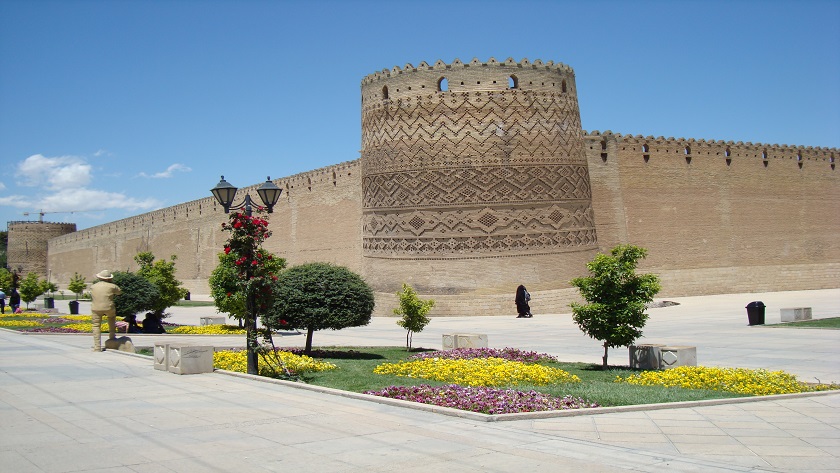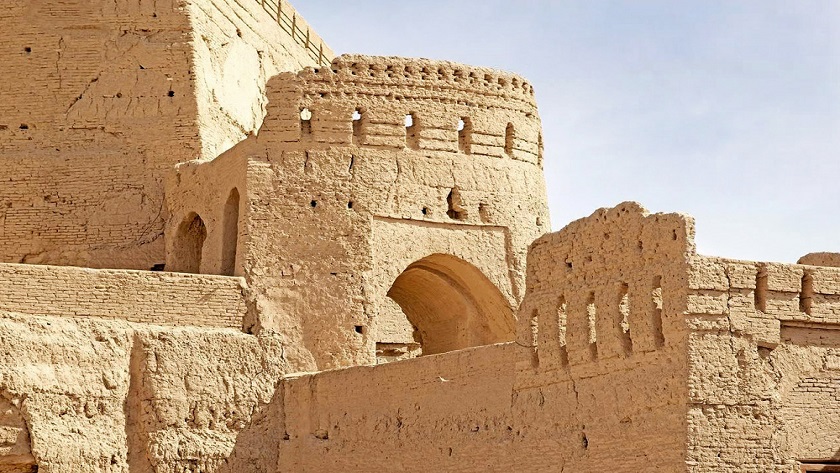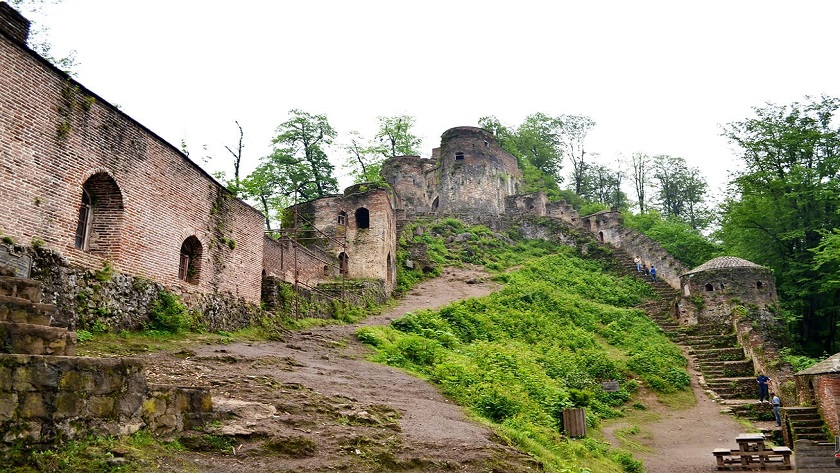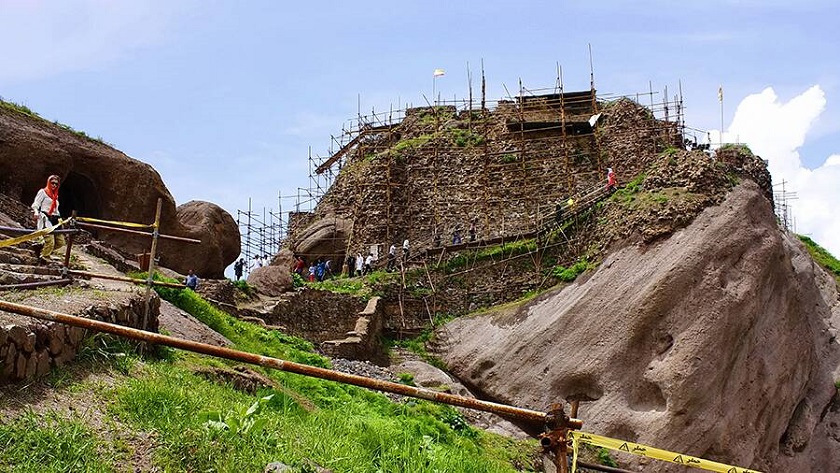Iran Press/Iran News: Fortresses have played an important role in strengthening nations throughout history and even in prehistoric times.
Castles were usually protected by governments along important roads or cities. The castles in ancient times were mostly built on high mountains or rocky slopes that served as a natural defensive factor against enemies.
Iran is no exception and has a number of unique historical fortresses. In most cities of Iran, these historic castles are found and most of them can be visited.
At present, many of Iran’s prominent castles are regarded as valuable tourist attractions.
Falak-ol-Aflak Castle
Falak-ol-Aflak castle is located on the top of the hill near the city of Khorramabad, the capital of Lorestan Province, western Iran, and dates back to the Sassanid era.
The historic castle is about 5,300 large its magnificent building dates back to the Sassanid era. The interior space of the castle includes four big halls, two backyards, several small halls, rooms, and gateways extending to the north.
 Iran's Falak-ol-Aflak Castle; an architectural masterpiece in the Sassanid era
Iran's Falak-ol-Aflak Castle; an architectural masterpiece in the Sassanid era
Falak-ol-Aflak castle has been renovated and reconstructed under Qajar. It has been registered on Iran's National Heritage List. Flak-ol-Aflak castle was rebuilt during the Qajar period.
The historical castle of Falak al-Aflak has been registered in the list of national monuments of Iran and has now been turned into a museum. Museums of Archaeology, and anthropology, an object restoration laboratory, and a traditional teahouse have been set up in the Castle.
 Karim Khan arg in Shiraz dates back to the 18th century
Karim Khan arg in Shiraz dates back to the 18th century
Karim Khan Arg
Shiraz, the city you should definitely have in your itinerary to visit, is where this unique Arg, proudly stands tall. When you step into the Arg, the different atmosphere of it from any other castle you’ve seen will surprise you. It belongs to the Zand Dynasty (1751-1794).
Karim Khan Zand built it for the royal family. The Arge is 4000 square meters with a big yard in the middle. Four 14 meters watchtowers, with walls 3 meters thick, 12 meters tall, and a moat all around them are for protection purposes. One of the towers similar to the Pisa tower is leaning and feels really something to watch.
 Karim Khan Citadel is part of a whole historical complex site
Karim Khan Citadel is part of a whole historical complex site
Inside the walls is heavenly pretty. Not only the trees, flowers and water pools but also the rooms are really awesome. Colorful windows, wooden doors, painted walls, traditional architecture, and art, plus the marble all are like a beautiful dream.
Narin Ghal’eh Castle
Located in the beautiful city of Meybod, in Yazd province, Narin Ghal’eh reminiscent of the Parthian and Sassanid era is standing magnificently above the central hill.
The ruins of this huge castle reach a height of about 40 meters. From the upper part of the castle, due to its high altitude, it is visible up to 70 km in any direction.
 Narin Castle in Yazd
Narin Castle in Yazd
Narin Ghal’eh, locally known as Narenj Ghal’eh (Orange Castle), is one of the most significant surviving works of authentic Iranian architecture and after over two thousand years, is still depicting the historical and cultural identity of Yazd in everyone’s mind.
Related article: Iran's Falak-ol-Aflak Castle; an architectural masterpiece in Sassanid era
The castle dates back to the Parthian and pre-Islamic eras and was repaired during the Muzaffarid period (14th c). There is a moat around it, and the burrows below it sometimes extend up to a few kilometers. Narin Ghal’eh has numerous interconnected rooms many of which are currently under excavation.
 Narin Castle in Yazd
Narin Castle in Yazd
Built entirely of clay and mud, the castle was used as a government citadel or military stronghold in various historical periods.
The peak of authority of this castle before Islam was in the Sassanid period and then in the Muzaffarid era. People from Maybod say there was an underground tunnel to the black stone mill in Bakhtar Abadi Bida village, 3 km west of Meybod.
Bam Castle
Located near the current city of Bam in Kerman province, the Bam castle, also known as Arg-e Bam (Bam Citadel) is the world’s largest mud brick structure which served as the government center of the old town of Bam.
It is listed by UNESCO as part of the World Heritage Site “Bam and its Cultural Landscape”.
 Bam arg in Kerman
Bam arg in Kerman
The first construction of this huge citadel on the Silk Road probably dates back to the Achaemenid Era (sixth to fourth centuries BC) and was used until 1850.
On 26th Dec 2003, a severe earthquake struck the area and caused huge damage to the site.
The citadel is approximately 180,000 m2 and has walls of 2 to 7 m in height and 1815 m in length.
Rudkhan Castle
A magnificent castle from the Sassanid era, 20 km southwest of Fouman. The castle, known as Ghal’eh Hesami or Ghal’eh Rudkhan, is next to a village of the same name.
Hidden in forests, with walls measuring 1500 meters long and 65 guard towers, it attracts numerous visitors who eagerly climb over 3000 steps in the mountain to reach the place.
The distance from Rudkhan castle to the town of Maklowan is 25 km, to Masuleh is 45 km, and to Shaft is 20 km. The castle is located at a height of 665 to 715 meters above sea level, next to a river of the same name.
 Rudkhan Castle in Gilan
Rudkhan Castle in Gilan
For the first time in 1830, a Polish discovered the fortress while recording the location of the monument in his notes.
He writes about it: “I found a fortress on top of a Guilan mountain in the upper part of Rudkhan river, its roof is made of stone and on both sides of the entrance there are two strong defensive towers.
There is an engraved inscription above the main entrance mentioning that the castle was rebuilt for King Sultan Hussam al-Din Amir Aladin Ishaq.
 Rudkhan Castle in Gilan
Rudkhan Castle in Gilan
Babak Fort
Babak Fort (Ghal’eh Babak or Babak Castle) is one of the largest castles in Iran, remaining from the Sassanid or Parthian period.
This castle, located at the height of 2300 meters in Arasbaran forests, is the strategic place where “Babak Khorram din” and his companions settled in and defended themselves against the enemies.
It is also known as the Eternal Castle, Immortal Fort, or the Republic Castle, and is referred to as a national symbol.
The reason for the naming is because of the courageous defense of Babak to oppose the Abbasid Arab invaders. Babak Castle has been refurbished several times over the centuries.
 Babak Castle is a large citadel on the top of a mountain in the Arasbaran forest
Babak Castle is a large citadel on the top of a mountain in the Arasbaran forest
Though there is not much left of the main structure, still we can imagine its glory in the past.
The Babak Fortress was designed in a way that those inside the castle could defend themselves with a small number of troops against a huge army.
This made Babak and his troops able to continue the struggle against the invaders for years. Like the castle of Alamut, it has only one entranceway and is surrounded by frightful valleys.
Ghaleh (Castle) Dokhtar
Ghal’eh Dokhtar, Dezh Dokhtar meaning “The Maiden Castle” is a castle built by Ardashir Babkan, the founder of the Sassanian Empire in 209 AD.
Located 6 km from Firouzabad, on a slope in the heart of the mountains, Ghaleh Dokhtar was a stronghold and served as an important obstacle for the enemies to cross the “Tangab Gorge”.
General architectural features of the palace inside this castle, in comparison with Ardashir palace in Firouzabad plain, show that the Maiden Castle was founded during Ardeshir I‘s wars with Parthians before his final victory over the last Parthian king, Ardavan V (Arthabanus V) in 224 AD.
 Ghale Dokhtar is a castle made by Ardashir I, in present-day Fars
Ghale Dokhtar is a castle made by Ardashir I, in present-day Fars
The main fortifications of Ghal’eh Dokhtar include an outer wall that extends over a sloping cliff with an overall shape of a trapezoid.
These fortifications started from the lower part of the “Tangab Gorge” and extended to the highest part of the mountain where the inner castle of the castle is located. The geometrical multi-level layout of the inner palace is in complete contrast to the non-geometrical mode of the castle itself, which is based on the natural shape of the mountain.
 Citadel of Rayen
Citadel of Rayen
Citadel of Rayen
Known as the largest raw brick building in the world after the citadel of Bam, Rayen raw brick citadel is Located 120 Km south of Kerman and occupies an area of 2,000 m².
This citadel looks similar to the citadel of Bam and is located at the top of a hill near Hazar mountain. The presence of this citadel proves that the city of Rayen existed before the arrival of Islam in Iran, and dates back to the Sassanid era.
 Rayen citadel in Kerman
Rayen citadel in Kerman
There were even older citadels in the area, which were destroyed after natural disasters over the centuries, however.
Rayen Citadel also served as one of the fortresses of Governor Mirzâ Hossein Khân at the time of Nâder Shâh Afshâr and his son Mohammad ’Ali Khân.
Alamut Castle
Alamut castle, one of the unique historical castles in Iran, is located in the northwest of Qazvin province on the top of a rock 200 m height upper than the surrounding lands.
This castle consists of two upper and lower castles built as a great building and the quadruplet walls of it are constructed by following the shape and conditions of the rocks so that the wall's width is especially varied in different parts.
 Alamut Castle in Qazvin province
Alamut Castle in Qazvin province
There are precipices around the castle on four sides and the only castle entrance is at the end of the northeast side of the castle. The castle is known for Hasan Sabbah, the propagandist of Ismailis religion in the Seljuk era in 428 AH.
Ashkan Salehian

